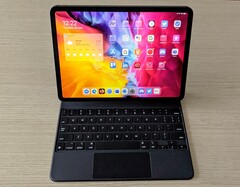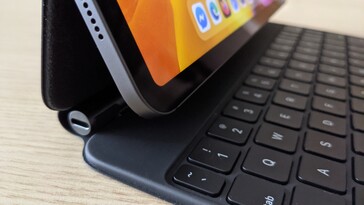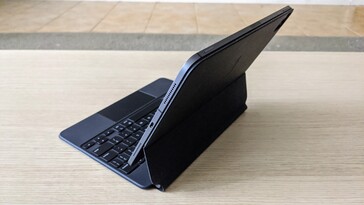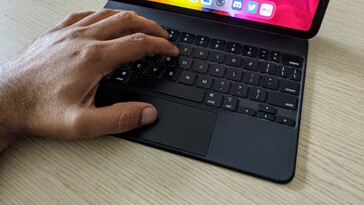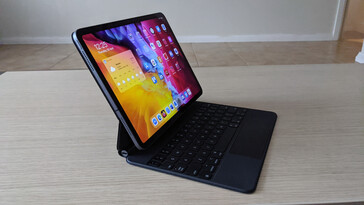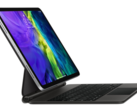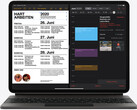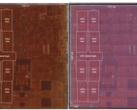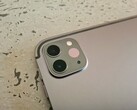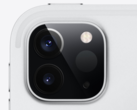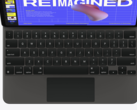Initial thoughts:
As a long-time iPad user who has been exploring other options over the past 12 to 24 months (including the Surface Pro X, the Galaxy Tab S5e and the Galaxy Book S), the unveiling of the iPad Pro Magic Keyboard accessory got me excited about the iPad again. I’ve been advocating for Apple to introduce proper mouse support on the iPad for a long time, as every attempt it has made to try to improve touch-based text manipulation on the iPad has never been completely satisfying. I’ve always liked the mobility of the tablet form factor but really missed the lack of trackpad support on the iPad given that the vast majority of my workflow involves writing and working with text. To say I was eagerly anticipating a hands-on with the Magic Keyboard is an understatement.
A Design Compromise:
One of the first things I noted about the cantilever design approach that Apple has adopted is, undoubtedly cool as it is, that it is the result of a design compromise. Producing a product that is fundamentally compromised by past design decisions is never a good starting point, leaving the team that designed the Magic Keyboard with some serious challenges to overcome. When the first generation of the new iPad Pro design was introduced back in 2018, it was clear that there was no intention at that time for Apple to introduce mouse support for this particular generation of iPads, as had always previously been the case. If you look at the Smart Keyboard Folio that preceded the new Magic Keyboard there was no requirement (or plan) to introduce trackpad support.
The keyboard on the Smart Keyboard Folio is placed further toward the user and the iPad was positioned in slots just in front of the keyboard, leaving absolutely no space for a mouse. Given that the second-generation of the iPad Pro design hasn’t changed, that clearly left Apple with a dilemma once it was decided that it would finally bite the bullet and introduce trackpad support. As a result of incorporating the trackpad and pushing the keyboard towards the iPad, Apple couldn’t fit in the stand slots, and obviously the solution has been to have the iPad "float" above the keyboard. This design decision alone is the reason the Magic Keyboard for the 11-inch iPad Pro weighs 601 grams - or 128 grams heavier than the 11-inch iPad Pro itself, which weighs in at 473 grams.
The Cantilever Pros and Cons:
The best thing about having the iPad positioned like this is that it really encourages you to interact with the device’s touchscreen in a seamless and natural way — going from the keyboard to touching the display just happens without even consciously thinking about it, such as for tapping word predictions. When it was positioned down in the slot of the Smart Keyboard Folio, the lower positioning was not as conducive to this much more natural interaction. The biggest downside of having the keyboard float over the keyboard is that your fingers can hit it when typing. This means you will need to find a position somewhere between where you might preferit angled and where it will be positioned best to type without hitting the bottom edge of the screen. If Apple had intended to include a touchpad with a cantilever right from the start, then this would clearly have been a compromise that would never have had to be made. However, it is in many ways a happy accident.
The Typing Experience:
As for the typing experience — it is so much better than the feel of the fabric-coated Smart Keyboard Folio that also hid Apple’s disastrous butterfly mechanism (yes, it was used here too and also resulted in extended support programs for iPad keyboard just like MacBook keyboards). The new, slightly scalloped, chiclet-style low-profile scissor switch mechanisms have a far better balance between feel and snappiness. It is also relatively quiet — much quieter than typing on the discarded butterfly mechanism fitted in MacBooks. The backlighting is also excellent and lights every key evenly, which is much more than can be said for other similarly backlit designs that we’ve seen.
The Trackpad:
The iPad Magic Keyboard with trackpad support is the answer to a lot of people’s prayers as it finally makes working with text-based apps like Microsoft Word, email or script-writing apps, for example so much easier. It is not to say that it was impossible in the past, but it was far from as simple or as straightforward as it should have been — particularly if it was ever to live up to Apple’s marketing hype that the iPad is the future of computing. Of course, it has lived up to those claims in many ways in particular, thanks to the incredible processing and graphics power Apple’s chip designers have been able to shoe-horn into its A-series chips. The trackpad is much smaller than we are used to seeing Apple employ on its MacBooks, a further hint that its inclusion is an afterthought and not by design. However, it is so welcome to have it that this is a minor gripe.
It is also made from the same (or similar) glass that Apple uses on its MacBooks. As such, it feels very smooth and is nice to touch and use for gestures. It also clicks evenly across the entire trackpad, although my preference is to activate the touch-based "tap to click" option that is mercifully included here as you would find on a MacBook - without it, I would like the Magic Keyboard a lot less than I do. Getting back to the gestures, these are still very useable (despite the small trackpad size), and very useful - in fact, it might get you using some of the gestures more than you might otherwise have used on the iPad screen itself. As a result, its introduction is an overwhelming success in every regard.
USB-C and the Smart Connector:
Another clever feature of the Magic Keyboard design is that Apple has utilized the Smart Connector on the rear to continue the non-Bluetooth connection required typing experience. At the same time, Apple has also added a new USB-C port into the keyboard design that, in effect, allows you to charge your iPad Pro wirelessly through the Smart Connector when placed on the cantilever. This also frees up the built-in USB-C port on the iPad Pro for other functions like adding external drive support or connecting your iPad Pro to a second display while still charging it. The tubular section where the USB-C connects to is actually made from aluminum and not plastic, which helps to reinforce the quality feel of the overall device.
Worth the weight?
The biggest knock against the new Magic Keyboard accessory is its weight. In combination with the 11-inch iPad Pro, it weighs 1.07 kg. This is heavier than the Samsung Galaxy Book S (960 grams), a laptop of which I am very fond. Yet, the Galaxy Book S offers a much larger 13.3-inch display and over twice the battery life of the iPad Pro. Moreover, the combination of the more comparable 12.9-inch iPad Pro and Magic Keyboard takes the weight up to 1.35 kg - this makes it even heavier than the 13.3-inch MacBook Air, currently the lightest laptop in Apple’s range. Not good. It veers very close to killing off the inherent advantages of compactness and portability that the tablet form factor offers.
Somehow, however, the overall effect of the Magic Keyboard and its design seems to keep Apple on the right side of this equation - at least when using the 11-inch iPad Pro/Magic Keyboard combination. A lot of it probably comes down to how well-balanced the iPad Pro sits on the cantilever mechanism and how securely the magnets fasten it into position. As a result, it has excellent "lapability" - far better than I had thought possible or expected. The fact that it doubles as a protective case when you are carrying it also puts it at an advantage over a device like the Galaxy Book S.
Conclusion:
Overall, the Magic Keyboard accessory really does transform the iPad experience and makes it a proper laptop alternative for the first time. Apple’s stubbornness in prolonging the wait for trackpad support created years of unnecessary frustration for users like me – as I indicated earlier in this piece, I’d actually given up on using an iPad for this very reason, and it is a game changer for me. It is a shame, then, that it is also so expensive with a price starting at US$299 for the 11-inch model. It will be interesting to try the 12.9-inch combo just to see whether it tips it over the other side of weight versus value and utility argument, which I suspect it might. Yes, the Magic Keyboard has flaws, but it doesn't mean that Apple hasn't put a tremendous amount of thought into making it work and, indeed, making the weight worth it.
Source(s)
Own




